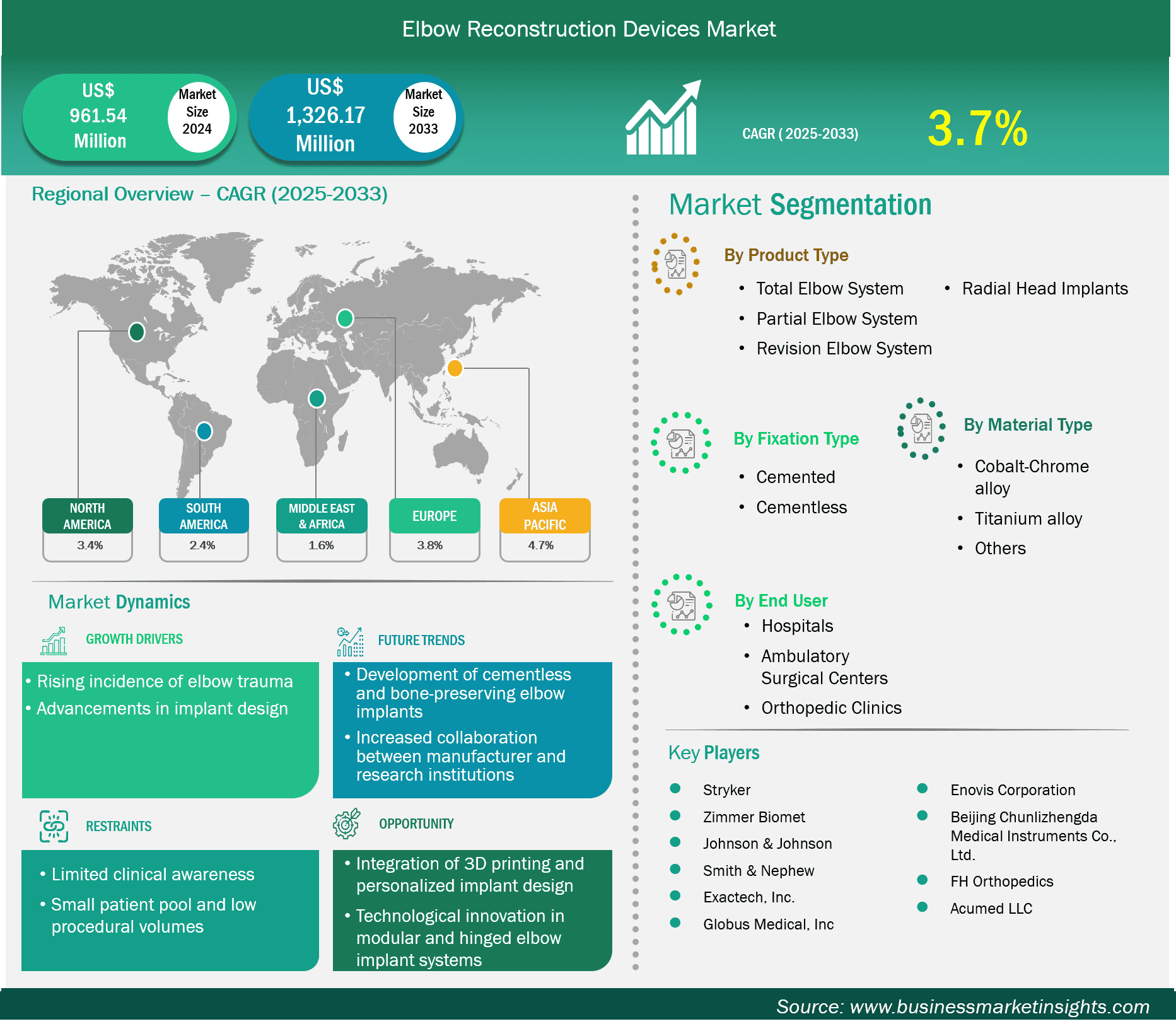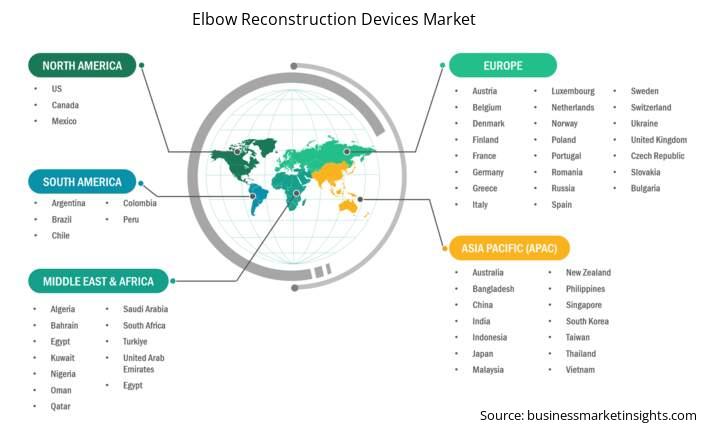Es wird erwartet, dass der Markt für Geräte zur Ellenbogenrekonstruktion von 961,54 Millionen US-Dollar im Jahr 2024 auf 1.326,17 Millionen US-Dollar im Jahr 2033 anwachsen wird. Von 2025 bis 2033 wird für den Markt eine durchschnittliche jährliche Wachstumsrate (CAGR) von 3,7 % erwartet.CAGR of 3.7% from 2025 to 2033.
Der Markt für Ellenbogenrekonstruktionsprodukte wächst langsam, da zunehmend komplexe Ellenbogenfrakturen, posttraumatische Arthritis und rheumatoide Arthritis auftreten. Obwohl es im Vergleich zur Hüft- oder Knieendoprothetik eine kleine Nische darstellt, steigt die Nachfrage, insbesondere bei älteren Patienten und Patienten mit schweren Gelenkschäden. Ellenbogenersatzverfahren wie die totale Ellenbogenendoprothetik und der Radiusköpfchenersatz finden zunehmend klinische Akzeptanz, was durch Fortschritte im Implantatdesign, der Operationsmethode und der postoperativen Behandlung begünstigt wird. Herausforderungen wie geringe Eingriffszahlen, erhöhte Komplikationsrisiken und mangelnde Erfahrung der Chirurgen schränken ihre breite Anwendung jedoch weiterhin ein.arthroplasty, demand is picking up, especially among older patients and those with extensive joint damage. Elbow replacement procedure such as total elbow arthroplasty and radial head replacements are increasingly being accepted clinically, encouraged by advances in implant design, surgical method, and post-operative management. Challenges such as low volume procedures, increased risks of complications, and restricted surgeon experience, nonetheless, still limit their wide application.
Entsprechend der Akzeptanzrate belief sich der globale Markt für Ellenbogenrekonstruktionsgeräte im Jahr 2024 auf 961,54 Millionen US-Dollar und wird bis 2033 voraussichtlich 1.326,17 Millionen US-Dollar erreichen. Schwellenländer bieten vielversprechende Wachstumschancen mit verbesserter Gesundheitsinfrastruktur und der Verfügbarkeit spezialisierter Versorgung. Innovationen bei patientenspezifischen, zementfreien und modularen Implantaten dürften die Entwicklung in diesem aufstrebenden orthopädischen Segment weiter vorantreiben.

Wichtige Segmente, die zur Ableitung der Marktanalyse für Geräte zur Ellenbogenrekonstruktion beigetragen haben, sind Produkttyp, Fixierungstyp, Materialtyp und Endbenutzer.
A traumatic injury is any physical injury that could cause serious medical conditions or be life-threatening. Elbow trauma can be caused due to factors such as fractures, dislocations, and ligament sprains, drives the elbow reconstruction devices market. Injuries are usually caused by falls, road traffic accidents, sporting injuries, or occupational injuries and can cause long-term joint pain, reduced range of motion, and joint instability. With active lifestyles and aging populations, the incidence of elbow-related injuries increases. With this increased clinical burden, surgical interventions like total elbow arthroplasty and radial head replacements are being used more frequently, particularly in non-healing or complex fractures. With rising number of people suffering from traumatic joint injuries which requires joint replacement procedure, the market for joint reconstruction devices is likely to flourish. Ongoing innovation in implant design is considerably improving the performance, longevity, and outcome of elbow reconstruction operations.
Contemporary implants are more anatomically shaped, modular, and light in weight, facilitating better fit and range of motion with reduced post-operative complications. More wear-resistant and biocompatible materials are improving implant longevity and decreasing revision rates. Technologies like linked and hinged prostheses offer increased joint stability in complicated cases, and modular designs enable patient anatomy customization. These design advances not only enhance surgeon confidence but also contribute to improved patient recovery and satisfaction. Consequently, more surgeons are delivering elbow arthroplasty as an effective remedy for trauma, arthritis, and failed previous treatments, and implant innovation is a significant stimulus of market growth.
By product type, the elbow reconstruction devices market is segmented into total elbow system, partial elbow system, revision elbow system and radial head implants. The total elbow system segment dominated the market in 2024. Total elbow arthroplasty (TEA) is the standard for severe joint degeneration, rheumatoid arthritis, or complex trauma. It accounts for the largest procedural volume, especially in older adults with low activity demands.
By fixation type, the elbow reconstruction devices market is segmented into cemented, and cementless. The cemented segment dominated the market in 2024. Cemented fixation offers superior immediate stability and is preferred in total elbow systems like Coonrad/Morrey and Nexel. It’s particularly important in osteoporotic or rheumatoid patients with poor bone quality.
By material type, the market is segmented into cobalt-chrome alloy, titanium alloy and others. The titanium alloy segment held the largest share of the market in 2024. Titanium alloys are commonly used for stems due to their favorable strength-to-weight ratio, corrosion resistance, and biocompatibility. Most modern implants feature titanium stems with cobalt-chrome articulating surfaces
By end user, the market is segmented into hospitals, ambulatory surgical centers, and orthopedic clinics. The hospitals segment held the largest share of the market in 2024. Elbow replacements, especially total systems, are complex surgeries that require comprehensive facilities and post-operative care—typically performed in hospitals rather than outpatient or clinic settings
| Report Attribute | Details |
|---|---|
| Market size in 2024 | US$ 961.54 Million |
| Market Size by 2033 | US$ 1,326.17 Million |
| Global CAGR (2025 - 2033) | 3.7% |
| Historical Data | 2022-2023 |
| Forecast period | 2025-2033 |
| Segments Covered | By Product Type
|
| Regions and Countries Covered | North America
|
| Market leaders and key company profiles |
|
The "Elbow Reconstruction Devices Market Size and Forecast (2022–2033)" report provides a detailed analysis of the market covering below areas:

The geographical scope of the elbow reconstruction devices market report is divided into five regions: North America, Asia Pacific, Europe, Middle East & Africa, and South & Central America. The elbow reconstruction devices market in Asia Pacific is expected to grow significantly during the forecast period.
The Asia Pacific elbow reconstruction devices market is segmented into China, Japan, South Korea, India, Australia, New Zealand, Indonesia, Malaysia, Philippines, Singapore, Thailand, Vietnam, Taiwan, Bangladesh and Rest of Asia. The Asia Pacific region leads in growth within the global market. The expansion in this region stems from a higher number of trauma cases more rheumatoid arthritis occurrences, and better access to orthopedic care. Japan, China, India, South Korea, and Australia stand out, thanks to better healthcare systems and more people knowing about ways to keep joints healthy or replace them. While elbow reconstruction isn't as common as hip or knee replacements, city centers see more demand. This is because of active lifestyles older populations, and more skilled doctors. Better implant designs and surgical methods are making results better, which encourages more people to try them. Also, the region's growing health tourism business and money put into special orthopedic training will help the market grow even more.
The elbow reconstruction devices market is evaluated by gathering qualitative and quantitative data post primary and secondary research, which includes important corporate publications, association data, and databases. A few of the key developments in the elbow reconstruction devices market are:
The Elbow Reconstruction Devices Market is valued at US$ 961.54 Million in 2024, it is projected to reach US$ 1,326.17 Million by 2033.
As per our report Elbow Reconstruction Devices Market, the market size is valued at US$ 961.54 Million in 2024, projecting it to reach US$ 1,326.17 Million by 2033. This translates to a CAGR of approximately 3.7% during the forecast period.
The Elbow Reconstruction Devices Market report typically cover these key segments-
Der historische Zeitraum, das Basisjahr und der Prognosezeitraum können je nach Marktforschungsbericht leicht variieren. Für den Marktbericht zu Ellenbogenrekonstruktionsgeräten gilt jedoch Folgendes:
Historischer Zeitraum: 2022–2023Basisjahr: 2024Prognosezeitraum: 2025–2033Der Markt für Ellenbogenrekonstruktionsgeräte wird von mehreren wichtigen Akteuren bevölkert, die jeweils zu seinem Wachstum und seiner Innovation beitragen. Zu den wichtigsten Akteuren gehören:
StrykerZimmer BiometJohnson & JohnsonSmith & NephewB. Braun SEExactech Inc.Globus Medical Inc.Enovis CorporationBeijing Chunlizhengda Medical Instruments Co., Ltd.FH OrthopedicsAcumed LLCDer Marktbericht zu Geräten zur Ellenbogenrekonstruktion ist für verschiedene Interessengruppen wertvoll, darunter:
Grundsätzlich kann jeder, der an der Wertschöpfungskette des Marktes für Geräte zur Ellenbogenrekonstruktion beteiligt ist oder eine Beteiligung daran in Erwägung zieht, von den Informationen eines umfassenden Marktberichts profitieren.